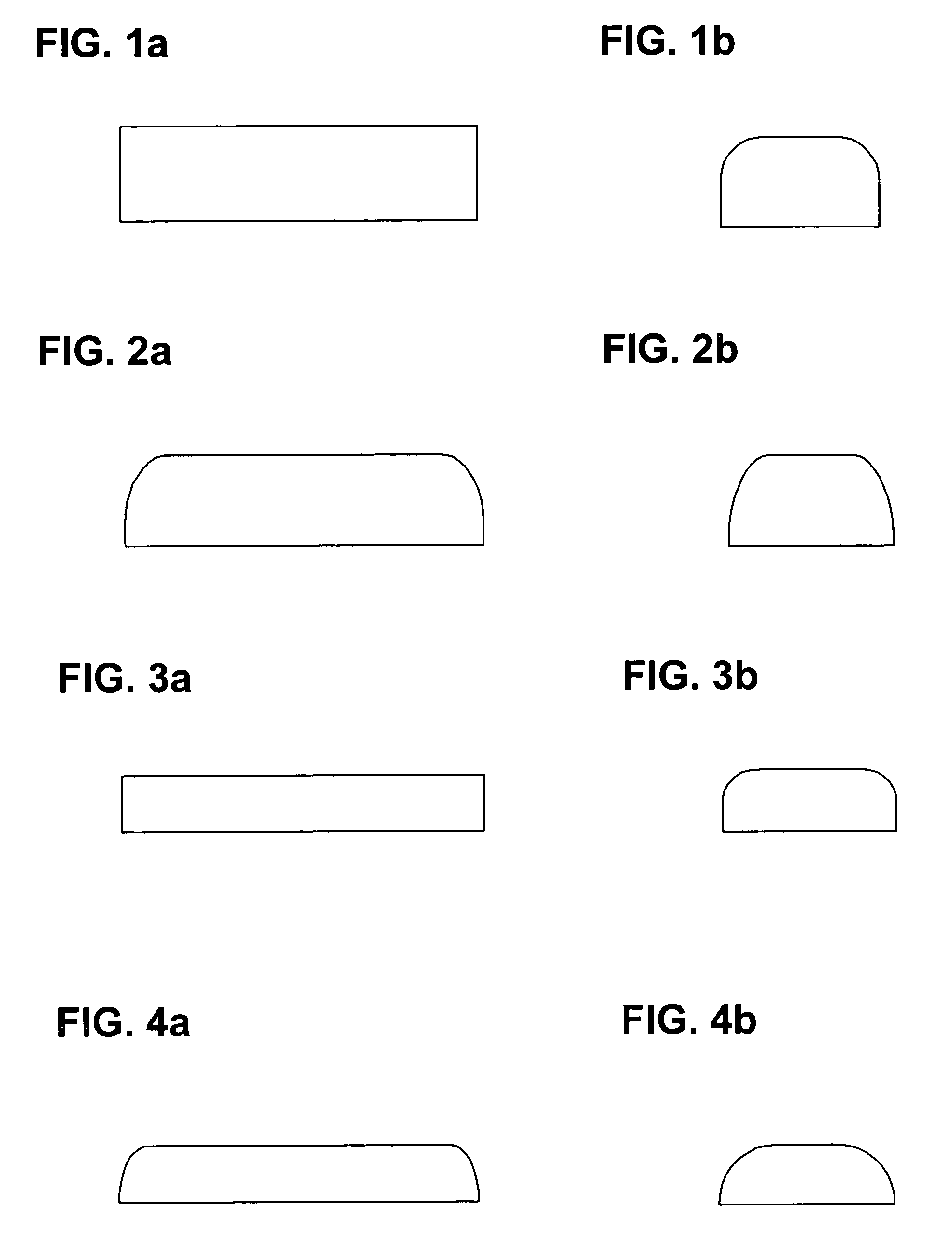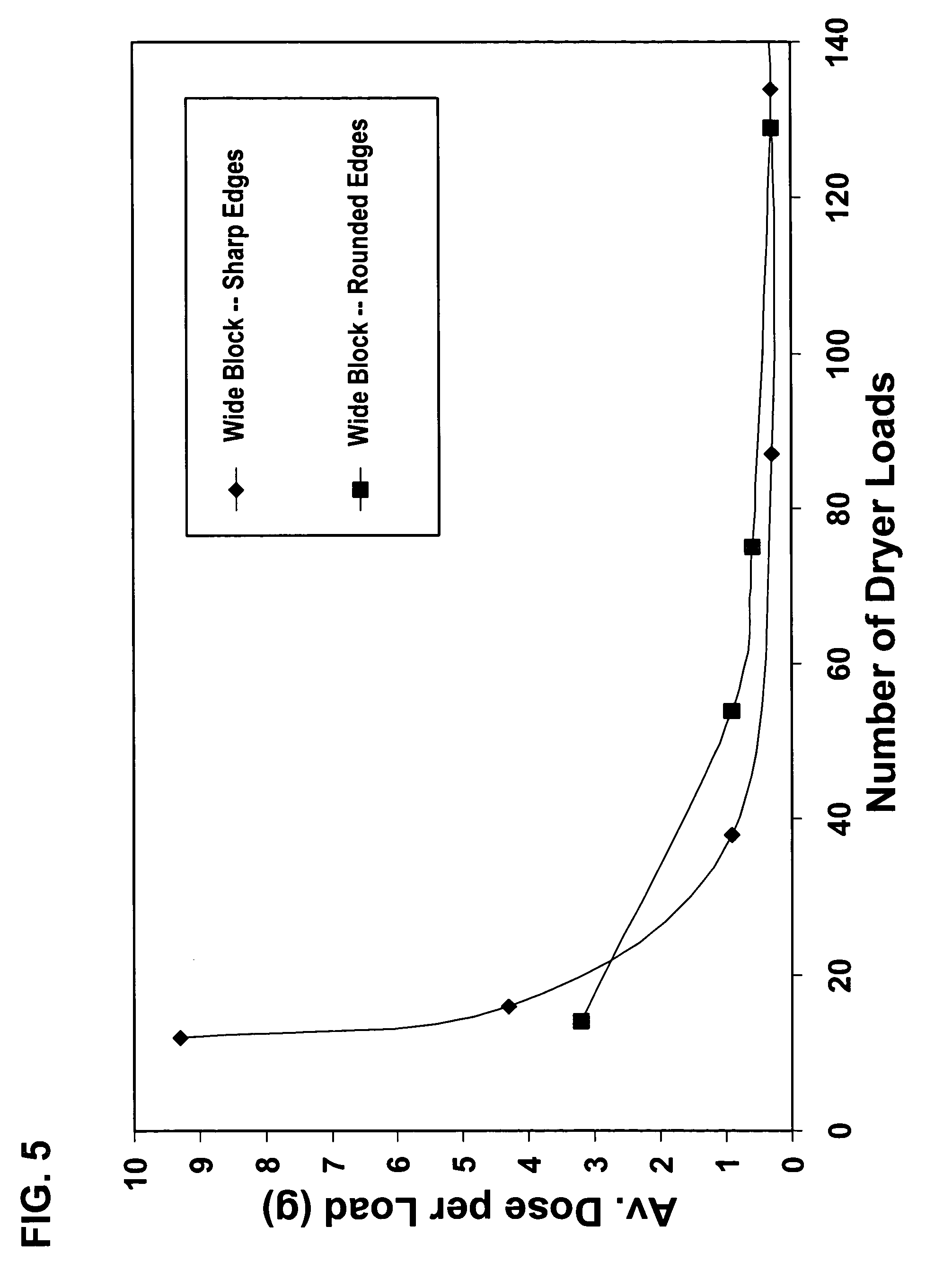Fabric treatment compositions and methods for treating fabric in a dryer
a technology of fabric treatment composition and dryer, which is applied in the direction of detergent composition, detergent compounding agent, surface-active detergent composition, etc., to achieve the effect of reducing the transfer rate of fabric treatment composition
- Summary
- Abstract
- Description
- Claims
- Application Information
AI Technical Summary
Benefits of technology
Problems solved by technology
Method used
Image
Examples
example 1
[0084]Seventeen fabric softener compositions for use in a dryer and providing antistatic and softening properties are presented in Table 1. The compositions are provided as solids exhibiting a melting point above 100° C.
[0085]
TABLE 1Fabric Softener CompositionsTrade NameChemical Name1234567810ArosurfDistearyl dimethyl50.060.070.077.067.057.060.555.545.5TA 100ammonium chloride,95%; propylene glycol,5%ArosurfDistearyl dimethylTA 101ammonium chloride,100%Acrawax CEthylene bistearamide50.040.030.020.015.035.030.050.0WitcoStearic30.025.010.0WaxmonoethanolamideTipinolDistyryl biphenyl2.52.52.52.52.52.5CBS-Sderivative (opticalbrightener)Fresh nFragrance0.50.50.52.02.02.0CleanHamposylSodium myristoylM-95sarcosinate, 95%FinquatQuaternium 75CT(a cationic quaternaryammonium ethosulfate)VarisoftDihydrogenated tallowDS-100dimethyl ammoniummethyl sulfate, 70%;nonionic surfactant, 30%VarisoftDihydrogenated tallow136–100dimethyl ammoniummethyl sulfate, 70%;alcohol ethoxylate, 30%VarisoftMethyl bis-...
example 2
[0097]Composition 17 in Table 1 uses a fabric softener component that can be considered non-yellowing. The fabric softener component is available under the name Varisoft 110-75% and includes 75% methyl bis-(hydrogenated tallow amidoethyl)-2-hydroxyethyl ammonium methyl sulfate, and 25% isopropanol. It is believed that during the melt mixing and casting of fabric softening composition 17, most, if not all, of the isopropanol flashed off. The twenty-cycle test was repeated with composition 17. Fifteen pounds of dry terry towel were used in this test, and WI and YI readings were taken before and after twenty cycles. The average weight loss with this formulation was 0.976 grams / cycle. This calculates to be approximately 54.5 ppm of active fabric softener component per cycle.
[0098]Calculation:
[0099](0.45×0.75) / (0.45×0.75+0.55)activesofteningcomponent×(0.976grams)×1,000,00015lbs×454g / lbs=54.5ppm
[0100]
TABLE 4Dispensing data for Composition 17; 20 cycle test with Compositi...
example 3
[0102]Additional fabric softening compositions are identified in Table 6. Composition 23 includes a non-yellowing fabric softener component available under the name Varisoft DS-110, and includes 70% methyl bis(hydrogenated tallow amidoethyl)-2-hydroxyethyl ammonium methyl sulfate, and 30% alcohol ethoxylate. The fabric softening quaternary ammonium compound was manufactured in a medium of alcohol ethoxylate.
[0103]Composition 23 was tested in a 20-cycle (wash and dry) test. Fifteen pounds of dry terry towel was used for this test. Results are shown in Tables 7 and 8. After twenty cycles, the average dispensing rate per cycle was 2.62 grams, delivering an average of 130 ppm active softening component.
[0104]
TABLE 6Fabric Softening CompositionTrade NameChemical Structure17181920212223Acrawax CEthylene55.040.040.050.052.551.551.5bistearamideFinquat CTQuaternium 75 (a5.0cationic quaternaryammoniumethosulfate)Varisoft 110 75%Methyl bis-45.060.050.050.047.548.5(hydrogenatedtallow amidoethyl...
PUM
| Property | Measurement | Unit |
|---|---|---|
| melting temperature | aaaaa | aaaaa |
| temperature | aaaaa | aaaaa |
| temperature | aaaaa | aaaaa |
Abstract
Description
Claims
Application Information
 Login to View More
Login to View More - R&D
- Intellectual Property
- Life Sciences
- Materials
- Tech Scout
- Unparalleled Data Quality
- Higher Quality Content
- 60% Fewer Hallucinations
Browse by: Latest US Patents, China's latest patents, Technical Efficacy Thesaurus, Application Domain, Technology Topic, Popular Technical Reports.
© 2025 PatSnap. All rights reserved.Legal|Privacy policy|Modern Slavery Act Transparency Statement|Sitemap|About US| Contact US: help@patsnap.com



